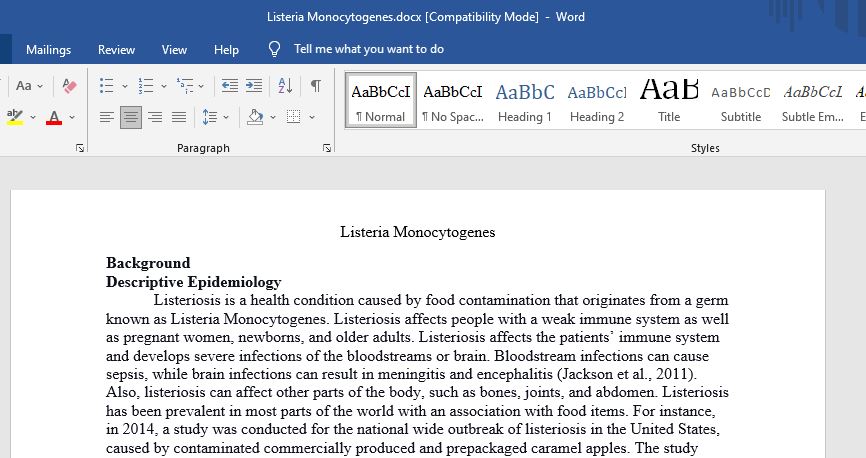Descriptive Epidemiology-Listeria Monocytogenes
• Descriptive epidemiology of listeriosis (describe how disease incidence and mortality are distributed by person, place, and time). This will comprise the largest portion of the Introduction/Background section. Be sure to include data! Feel free to include figures and short tables from publications (e.g. CDC publications) – be sure to cite with a superscript number and include the citation in the reference section
• Objective(s) – Simply state objective of the paper (e.g. The objective of the study was to review published outbreak investigations for [disease X] and to assess investigative methods…)
• NOTE: the articles cited in this section of the review are not the same articles identified as a result of the methods described below and thus are not part of the systematic review.
Results (1-2 pages): describe what the outbreak investigations included in the review found (18 pts)
• Indicate the number of articles initially identified and the number of articles identified after applying the inclusion/exclusion criteria (text version of figure described in Methods section above)
• Describe the results of the investigations collectively – that is, summarize each of the items below for the studies as a group. NOTE: feel free to add items based on your review
o Impact (e.g. # people affected, # states involved, morbidity and mortality, etc.)
o Identification (i.e. how were the outbreaks initially identified/detected?)
o Case finding (i.e. how were subsequent cases identified?)
o Investigative methods (i.e. study design or approach used to determine source)
o Control measures (i.e. interventions used to control the outbreak)
o Limitations (i.e. limitations of the investigations)
• Include a table summarizing articles/outbreaks identified (columns should include at a minimum: lead author, year, setting/location, study design, # cases, source(s) of infection or risk factors with estimates of measure(s) of association, if applicable [i.e. provide data!]). Use MS Word table function. Include a descriptive title.
NOTE: the focus of outbreak investigations into different types of diseases will vary. For example, published outbreak investigations of vaccine preventable diseases tend to focus implementing and evaluating control measures (i.e. vaccination, isolation, etc.). Published outbreak investigations of a foodborne outbreak tend to focus on identifying the implicated food item. Feel free to tailor your results section (particularly the third item above) to the investigations reviewed. Similarly, note that some investigations will not use a formal epidemiologic study design. For example, investigations into a rare but serious disease may only include a handful of cases. In this instance, a case series was used and often, the cases are simply described and do not include measures of association (e.g. OR or RR). Again, you can tailor your review to fit your disease. Rest assured, I will alter the rubric as well.
Discussion (2-3 pages): Synthesize the results of the outbreak investigation – what do they mean? (15 pts)
• Summarize and discuss significance of key findings – that is, those that are consistent across the outbreaks (e.g. source(s) of infection, study design, control measures used, populations affected, limitations, laboratory techniques, etc.)
• Identify at least 3 strengths and 3 limitations of your review (not the individual investigations)
• Provide at least 3 of your recommendations to prevent and control future outbreaks, indicating how they can be used and by whom
• Conclusions: final paragraph summarizing key conclusions
I also attached my draft method to write for the result and discussion sections and rubrics here
I can provide the pdfs for articles.
Answer preview:

word limit:2340
